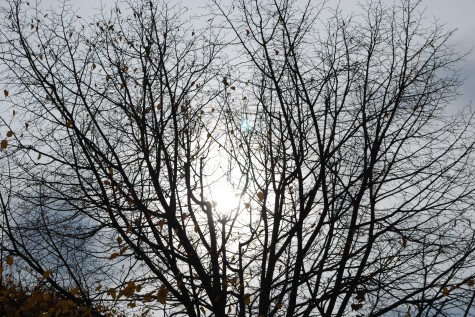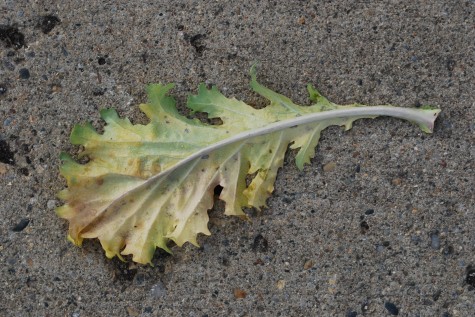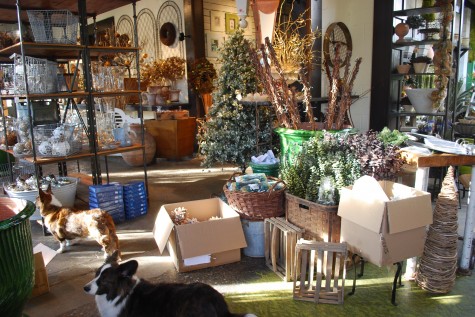 Though I shopped this past January for the holiday, and most everything was here this past August, I am never ready for what it really takes to change seasons. Have you ever? Even the corgis have that slightly appalled look on their faces. I am certain that the 10,000 square feet I have to deal with is secretly multiplying in the dead of night. It seems that everything needs to get moved-at least twice. Spaces have to be cleared-and of course cleaned-before they can be re-imagined. Sometimes it seems like my imagination will never ignite. When that everything involves stone, steel and lead, I have been known to daydream about being in the stamp-collecting business.
Though I shopped this past January for the holiday, and most everything was here this past August, I am never ready for what it really takes to change seasons. Have you ever? Even the corgis have that slightly appalled look on their faces. I am certain that the 10,000 square feet I have to deal with is secretly multiplying in the dead of night. It seems that everything needs to get moved-at least twice. Spaces have to be cleared-and of course cleaned-before they can be re-imagined. Sometimes it seems like my imagination will never ignite. When that everything involves stone, steel and lead, I have been known to daydream about being in the stamp-collecting business.
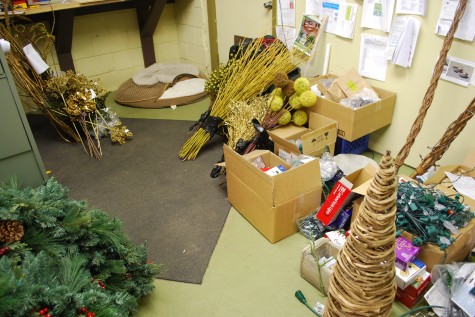 Rob likes everything imaginable in front of him all at once. The disaster that is his desk-loaded with messages, invoices, catalogues, notes, and all manner of other bits, spreads to the floorspace like a slime mold on steroids. This week he has been working away on the last of my leftover Halloween candy; the combination of his blood sugar level and his natural propensity to disorder defies description. Suffice it to say, I am living in a universe tending towards dissolution.
Rob likes everything imaginable in front of him all at once. The disaster that is his desk-loaded with messages, invoices, catalogues, notes, and all manner of other bits, spreads to the floorspace like a slime mold on steroids. This week he has been working away on the last of my leftover Halloween candy; the combination of his blood sugar level and his natural propensity to disorder defies description. Suffice it to say, I am living in a universe tending towards dissolution.
 The greenhouse fernery, so gorgeous a week ago, is now bulging with all those things that have lost their homes, and have no place to go. An impossibly delicate terra cotta pot with applied roses from Espace Buffon in Paris is one of a hundred fragile items crowding my office conference table. What floor space is still available makes walking through any room, objects in tow, nervewracking. Should anyone out there know of a small scale hovercraft rated for interior use, please let me know.
The greenhouse fernery, so gorgeous a week ago, is now bulging with all those things that have lost their homes, and have no place to go. An impossibly delicate terra cotta pot with applied roses from Espace Buffon in Paris is one of a hundred fragile items crowding my office conference table. What floor space is still available makes walking through any room, objects in tow, nervewracking. Should anyone out there know of a small scale hovercraft rated for interior use, please let me know.
 The rear portion of the shop is a cavernous garage-at least it seemed that way when I bought the building in 1995. Today every square foot has something going on, and not in any particular order. The arrangement of boxes so neatly shelved and stored has become completely unglued. The corgis treat this space like a formula one course, fraught with hairpin turns and unexpected obstructions. Great fun for them-not so much for me. This space needs to be shovelled out soon, such that we have room for the crew and materials necessary to construct of all our winter and holiday decor.
The rear portion of the shop is a cavernous garage-at least it seemed that way when I bought the building in 1995. Today every square foot has something going on, and not in any particular order. The arrangement of boxes so neatly shelved and stored has become completely unglued. The corgis treat this space like a formula one course, fraught with hairpin turns and unexpected obstructions. Great fun for them-not so much for me. This space needs to be shovelled out soon, such that we have room for the crew and materials necessary to construct of all our winter and holiday decor.
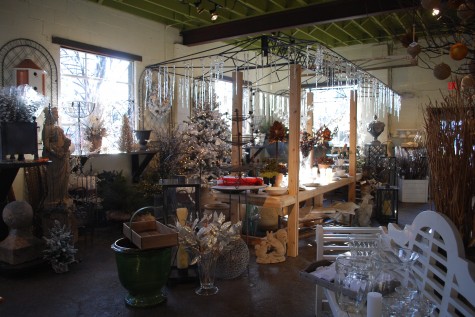 Progress has been made; certain big gestures are in place. Every box I unpack, I hope I remember what I was thinking when I bought ,works out. My idea of holiday has everything to do with materials and references to the garden. This part is simple. It takes a great deal of concentration to shop materials from 30 or better vendors such that you end up with a cohesive collection; this is only the beginning. Remembering what I had in mind over 10 months ago-even my notes don’t ring any bells. The materials pile up faster than I can do display; just this morning a semi truckload of twigs arrived. At this moment, the driveway is impassable.
Progress has been made; certain big gestures are in place. Every box I unpack, I hope I remember what I was thinking when I bought ,works out. My idea of holiday has everything to do with materials and references to the garden. This part is simple. It takes a great deal of concentration to shop materials from 30 or better vendors such that you end up with a cohesive collection; this is only the beginning. Remembering what I had in mind over 10 months ago-even my notes don’t ring any bells. The materials pile up faster than I can do display; just this morning a semi truckload of twigs arrived. At this moment, the driveway is impassable.
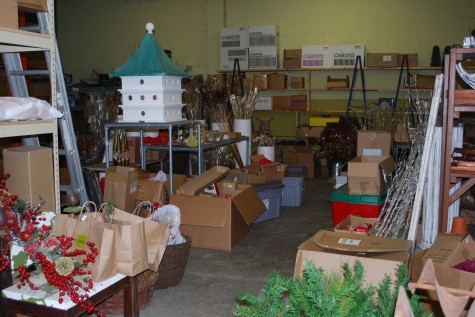
Though this scene smacks of a storage facility whose loading in has never been accompanied by any loading out, my clients seem to like this phase. They amiably poke through everything, and have no problem asking to have a promising box opened for them-thank heavens. They even go so far as to say how beautiful everything looks-I think they feel sorry for me. This process takes a month anyway, start to finish. I learned a long time ago, if you do not set a deadline, you will never be done.
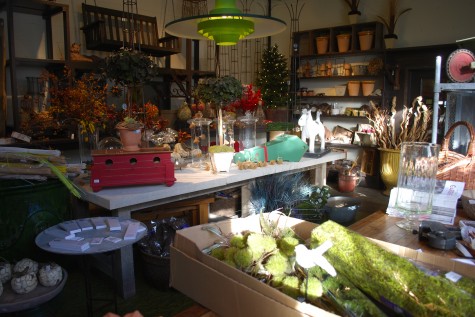 Next week Thursday November 12th is our deadline. We host an evening holiday preview and shopping soiree for our clients. Our 4pm to 9pm event ran until 11:30 last year. We serve a little something to eat and drink; lots of people come, and we have a great time. We aim for picture perfect, we are 6 days out and counting. I don’t see how we will be ready this minute, but somehow we will get there. Stop in, should you have a chance.
Next week Thursday November 12th is our deadline. We host an evening holiday preview and shopping soiree for our clients. Our 4pm to 9pm event ran until 11:30 last year. We serve a little something to eat and drink; lots of people come, and we have a great time. We aim for picture perfect, we are 6 days out and counting. I don’t see how we will be ready this minute, but somehow we will get there. Stop in, should you have a chance.
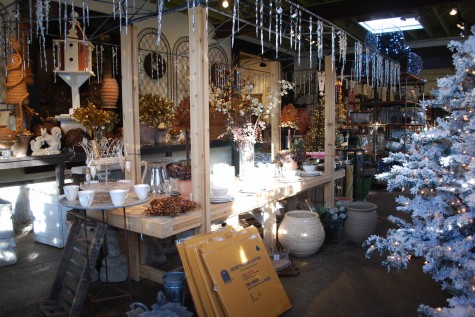
Now, where was I?
 Some months ago I wrote an essay about designing a landscape for a sculpture, but perhaps equally as sculptural were the tree trunks that played such a critical role in the realization of that design. I do not think I ever physically understood what a tree was all about until I was face to face with these stumps. Farmers need to clear land to plant their crops; this means digging out the stumps. The microorganisms that decompose wood work at a snail’s pace. In farm areas in Michigan it is common to see fences made from these stumps. For this project, I persuaded a farmer to part with 150 feet of his fence. The experience would provide me with a graphic understanding of what goes on inside the bark of a tree.
Some months ago I wrote an essay about designing a landscape for a sculpture, but perhaps equally as sculptural were the tree trunks that played such a critical role in the realization of that design. I do not think I ever physically understood what a tree was all about until I was face to face with these stumps. Farmers need to clear land to plant their crops; this means digging out the stumps. The microorganisms that decompose wood work at a snail’s pace. In farm areas in Michigan it is common to see fences made from these stumps. For this project, I persuaded a farmer to part with 150 feet of his fence. The experience would provide me with a graphic understanding of what goes on inside the bark of a tree. 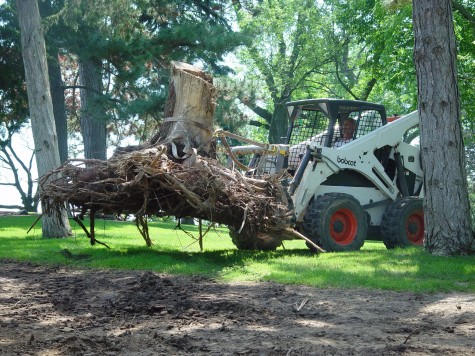 What arrived by flatbed was vastly more than I had bargained for. They stood eight feet tall and were much better than that in width. Though the fence had been in place for 10 years, handling the size and weight of them was a strain both for my crew, and my bobcat skid steer. The thick wiry roots were as unyielding as steel. It is so easy to stop truly seeing those things one sees every day. A lifetime of seeing these giant living things rising out of the ground to incredible heights had apparently dulled my sense of them.
What arrived by flatbed was vastly more than I had bargained for. They stood eight feet tall and were much better than that in width. Though the fence had been in place for 10 years, handling the size and weight of them was a strain both for my crew, and my bobcat skid steer. The thick wiry roots were as unyielding as steel. It is so easy to stop truly seeing those things one sees every day. A lifetime of seeing these giant living things rising out of the ground to incredible heights had apparently dulled my sense of them. 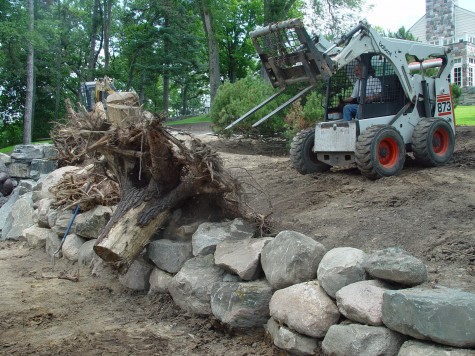 I was so struck by how the heart of a tree lives on long after its green life has gone down. The heartwood is transformed by an internal chemical process into a material of great strength. The wood of a tree enables nutrients to travel from the roots to the leaves, its core function is to keep the plant upright. This exposure to wood is much different than looking at planks, or plywood, porch furniture, or fuel for my fireplace. Processed wood is obviously a material that few could do without, but these raw forms are incredibly beautiful.
I was so struck by how the heart of a tree lives on long after its green life has gone down. The heartwood is transformed by an internal chemical process into a material of great strength. The wood of a tree enables nutrients to travel from the roots to the leaves, its core function is to keep the plant upright. This exposure to wood is much different than looking at planks, or plywood, porch furniture, or fuel for my fireplace. Processed wood is obviously a material that few could do without, but these raw forms are incredibly beautiful.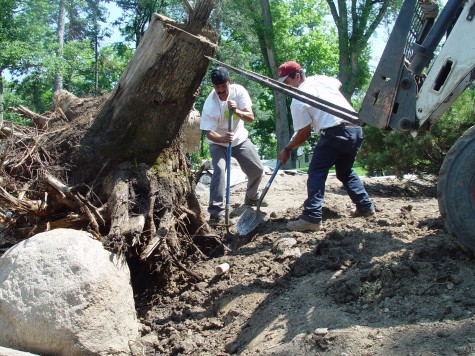 Setting them in place took days. Placing them close to the final location was done by machine. This was just the beginning; as I wanted them to look as though they might had always been there, we dug them in. The forks on the skid steer held the stumps in place, as it would have taken an army to do that by hand. Though this group of trees was no longer living, the story of how the network of feeder and support roots broadly rise out of the ground and grow to support these very large plants is there to read.
Setting them in place took days. Placing them close to the final location was done by machine. This was just the beginning; as I wanted them to look as though they might had always been there, we dug them in. The forks on the skid steer held the stumps in place, as it would have taken an army to do that by hand. Though this group of trees was no longer living, the story of how the network of feeder and support roots broadly rise out of the ground and grow to support these very large plants is there to read. 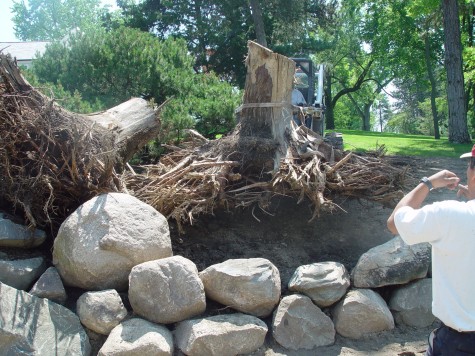
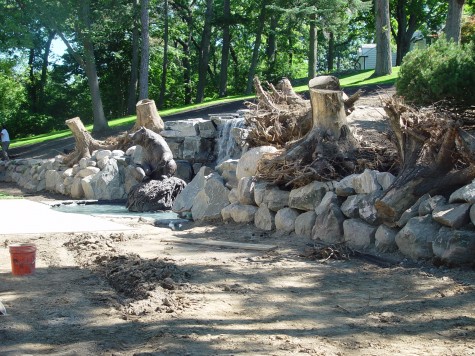 It is a very good idea to consider what will need to go on below ground, and what will eventually be-before planting a large growing tree. I have had occasion to tell clients that their silver maples were an excellent example of God’s biggest weeds. Urban lots and tree lawns are poor locations for giant trees. They suffer from restricted space and rootzones. Given that it takes a long time to grow a tree, imagining the eventual size at the beginning only makes good sense.
It is a very good idea to consider what will need to go on below ground, and what will eventually be-before planting a large growing tree. I have had occasion to tell clients that their silver maples were an excellent example of God’s biggest weeds. Urban lots and tree lawns are poor locations for giant trees. They suffer from restricted space and rootzones. Given that it takes a long time to grow a tree, imagining the eventual size at the beginning only makes good sense.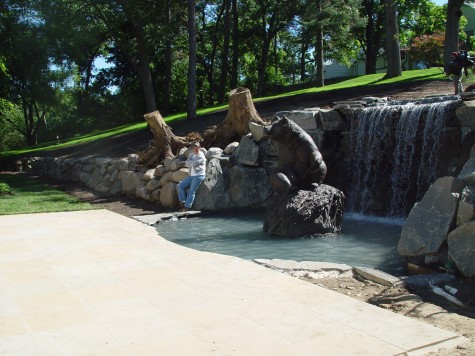 This nine foot tall bronze bear seated on his beaver’s nest is getting some company of a similar scale. The rain to come will wash the stumps. The digging in will deposit soil in pockets, enabling plants to grow. A collection of dwarf conifers would cover the ground.
This nine foot tall bronze bear seated on his beaver’s nest is getting some company of a similar scale. The rain to come will wash the stumps. The digging in will deposit soil in pockets, enabling plants to grow. A collection of dwarf conifers would cover the ground.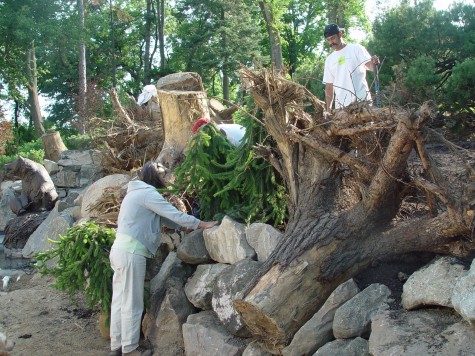
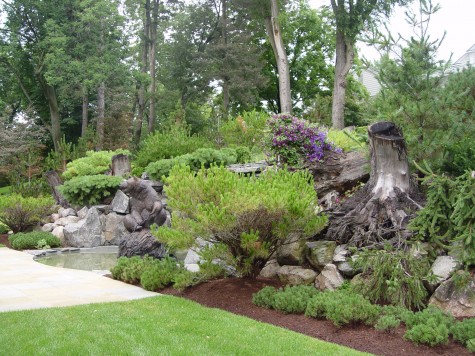
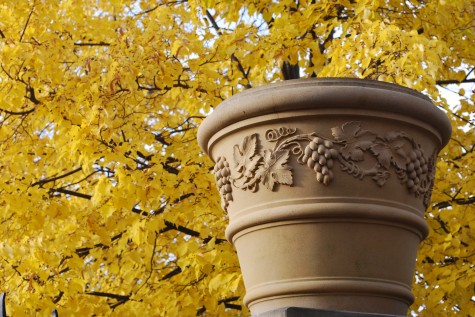 The fall is the perfect time to talk about light as an element of design in the landscape. How, when and where the sun shines, dramatically influences the visual impact of any landscape or garden. October light in Michigan is cold and low in the sky. Uneven or carved surfaces are cast in sharp relief. Any shadows cast will be dramatically elongated. A client choosing a smooth surfaced ornament for their garden should be happy for a subtle light rendering; if not, choosing ornament with some more graphic surface variation might be in order.
The fall is the perfect time to talk about light as an element of design in the landscape. How, when and where the sun shines, dramatically influences the visual impact of any landscape or garden. October light in Michigan is cold and low in the sky. Uneven or carved surfaces are cast in sharp relief. Any shadows cast will be dramatically elongated. A client choosing a smooth surfaced ornament for their garden should be happy for a subtle light rendering; if not, choosing ornament with some more graphic surface variation might be in order.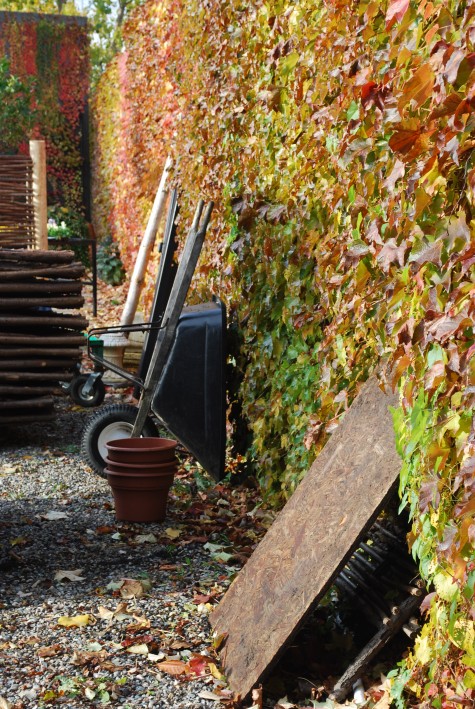 I could write on into the next decade about how light is the engine that gets any outdoor space moving. One of my favorite parts of my Michigan gardening life is how the light can make the appearance of everything change, from hour to hour, and day to day, and season to season. The contrast of light and dark in a garden is its heartbeat. In October, the trees coloring up are all the more dramatic for the ignition supplied by that intensely pale light. Its worth thinking about the degree of shade a tree or shrub will cast in a landscape. A densely shady area is all the more dramatic with a pocket pool of light behind it. Plan for dark spaces close to your view, with light spaces in the distance.
I could write on into the next decade about how light is the engine that gets any outdoor space moving. One of my favorite parts of my Michigan gardening life is how the light can make the appearance of everything change, from hour to hour, and day to day, and season to season. The contrast of light and dark in a garden is its heartbeat. In October, the trees coloring up are all the more dramatic for the ignition supplied by that intensely pale light. Its worth thinking about the degree of shade a tree or shrub will cast in a landscape. A densely shady area is all the more dramatic with a pocket pool of light behind it. Plan for dark spaces close to your view, with light spaces in the distance.  The spring leaves emerging on my Princeton gold maples cannot hold a candle to their yellow fall fire. I am a photographer whose lack of understanding about the mechanics of photography is considerable. So I watch the light. When it suffuses every element in a garden such that the color in my pictures, or the feeling of my pictures, will be saturated-that is the time I photograph. I record; I do not have the skills to generate. It is hard to believe this collection of these maple yellow leaves produces such dense shade underneath; the grey cedar fence appears black by way of contrast, and almost disappears.
The spring leaves emerging on my Princeton gold maples cannot hold a candle to their yellow fall fire. I am a photographer whose lack of understanding about the mechanics of photography is considerable. So I watch the light. When it suffuses every element in a garden such that the color in my pictures, or the feeling of my pictures, will be saturated-that is the time I photograph. I record; I do not have the skills to generate. It is hard to believe this collection of these maple yellow leaves produces such dense shade underneath; the grey cedar fence appears black by way of contrast, and almost disappears.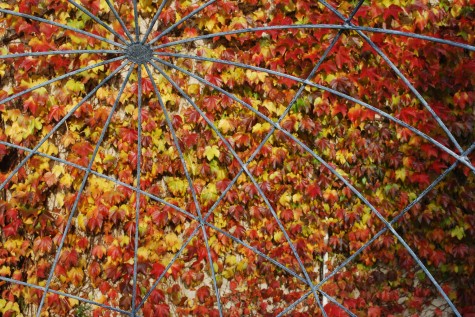 Our thin rod steel spheres permit the view of your choice through to the landscape. How they interact with a garden is the best part about them. Imagine this view in the winter, the early spring, the early summer, the high summer, the fall; you get the idea. Add light to the mix, and your possible visual combinations increase considerably. Garden ornament interests me greatly, given how it offers me a sense of solidity, and steadfast longevity, against the ever changing landscape.
Our thin rod steel spheres permit the view of your choice through to the landscape. How they interact with a garden is the best part about them. Imagine this view in the winter, the early spring, the early summer, the high summer, the fall; you get the idea. Add light to the mix, and your possible visual combinations increase considerably. Garden ornament interests me greatly, given how it offers me a sense of solidity, and steadfast longevity, against the ever changing landscape. 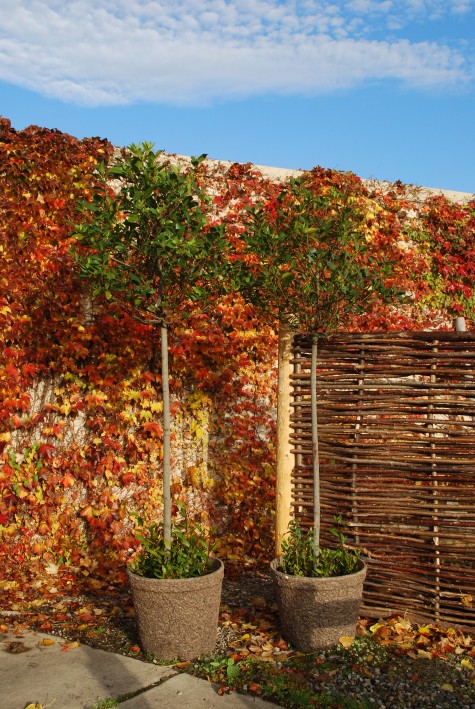 The bright flat October sun sets all it touches on fire. The greens are all that much more electrically green; the reds glow red. If you are looking to see the rhythm established by the masses of light and dark in your landscape, look quick now before the leaves fall. There is instruction coming from the natural world every day, should you care to tune in.
The bright flat October sun sets all it touches on fire. The greens are all that much more electrically green; the reds glow red. If you are looking to see the rhythm established by the masses of light and dark in your landscape, look quick now before the leaves fall. There is instruction coming from the natural world every day, should you care to tune in.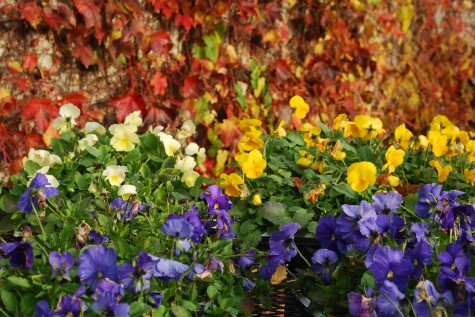 The color of these pansies speaks softly in the spring. The fall light intensifies and electrifies the appearance of their color. On my best days, I think about how the light will fall on a landscape in every season, as this should influence how I place every plant or object.
The color of these pansies speaks softly in the spring. The fall light intensifies and electrifies the appearance of their color. On my best days, I think about how the light will fall on a landscape in every season, as this should influence how I place every plant or object.
